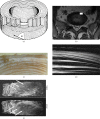Review. The Agfa Mayneord lecture: MRI of short and ultrashort T₂ and T₂* components of tissues, fluids and materials using clinical systems
- PMID: 22101579
- PMCID: PMC3473831
- DOI: 10.1259/bjr/74368403
Review. The Agfa Mayneord lecture: MRI of short and ultrashort T₂ and T₂* components of tissues, fluids and materials using clinical systems
Abstract
A variety of techniques are now available to directly or indirectly detect signal from tissues, fluids and materials that have short, ultrashort or supershort T₂ or T₂* components. There are also methods of developing image contrast between tissues and fluids in the short T₂ or T₂* range that can provide visualisation of anatomy, which has not been previously seen with MRI. Magnetisation transfer methods can now be applied to previously invisible tissues, providing indirect access to supershort T₂ components. Particular methods have been developed to target susceptibility effects and quantify them after correcting for anatomical distortion. Specific methods have also been developed to image the effects of magnetic iron oxide particles with positive contrast. Major advances have been made in techniques designed to correct for loss of signal and gross image distortion near metal. These methods are likely to substantially increase the range of application for MRI.
Figures








References
-
- Spiers FW. William Valentine Mayneord. Biogr Mems Fell R Soc 1991;37:343–64
-
- Lamerton LF. Obituary Professor W V Mayneord CBE, DSc, FInstP, FRS. Br J Radiol 1988;61:1093–4 - PubMed
-
- Mayneord WV. Physics in medicine. Br Med Bull 1945;3:129–32
-
- Young IR, Khenia S, Thomas DG, Davis CH, Gadian DG, Cox IJ, et al. Clinical magnetic susceptibility mapping of the brain. J Comput Assist Tomogr 1987;11:2–6 - PubMed
-
- Haacke EM, Reichenbach JR, (eds). Susceptibility weighted imaging in MRI: basic concepts and clinical applications. Hoboken, NJ: Wiley-Blackwell, 2011
Publication types
MeSH terms
Substances
LinkOut - more resources
Full Text Sources
Medical

